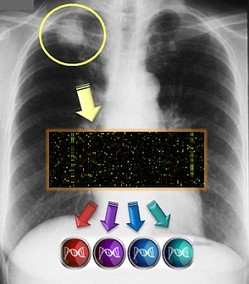A gene expression signature can identify lung cancer patients who are likely to relapse even after surgical removal of the tumor

Patients at high risk of a relapse of lung cancer after surgical removal of their tumor can be accurately identified from a gene expression signature in affected tissue.
Photograph: c iStockphoto/Zakai
Image: c 2010 T. Takahashi
Lung cancer can in many cases be cured if diagnosed and treated in the early stages when tumors are more amenable to surgical removal. But even early treatment is no guarantee of long-term survival; over 30% of patients treated for early-stage lung cancer suffer a relapse. Clinicians predict disease outcome in lung cancer patients using imaging technologies designed to visualize the size and spread of tumors. Present imaging techniques, however, are unable to identify the residual cancer cells that could lead to a future relapse. Now, Takashi Takahashi of the Nagoya University GCOE for Molecular Medicine and co-workers have developed a more accurate method for predicting lung cancer outcome based on markers in the genes of lung cancer tissue removed from a patient during surgery1.
The researchers began by comparing whole genome expression profiles of lung cancer tissue from patients who were relapse-free and still alive more than five years after tumor removal with those of patients who relapsed and died within five years of tumor removal. From this comparison, the team found 82 changes in gene expression that they could use to accurately segregate these populations into groups at low and high risk of relapse.
Takahashi and his co-workers then validated that this gene signature could predict disease outcome in a separate group of lung cancer patients. They also confirmed that relapse-free survival was much more likely for the low-risk population. Indeed, using the gene signature, they accurately predicted a dismal prognosis for patients from the high-risk group, even in those patients whose tumors were classed as early stage using conventional imaging techniques. "The expression signature appears to be useful for identifying lung cancer patients at very high risk of relapse, even those in the early stage," says Takahashi, "which may ultimately improve patient prognosis following surgery for this deadly cancer."
To confirm that this was the case, the team's gene expression profiling technique was applied to another population of patients whose tumors had been classified as early-stage lung cancer using imaging techniques. In this population, the gene expression profile proved more accurate than tumor stage at predicting overall survival and relapse-free survival of the patients.
Takahashi and his team believe that this gene signature could improve clinical evaluation for individual lung cancer patients, and may eventually lead to better personalized therapy based on the expression signature-based prediction. To allow for clinical use of this gene signature in lung cancer, Takahashi notes that "a clinical trial for patient-tailored therapy with stratification according to the molecular signature is needed."
Affiliated Researchers
The Nagoya University affiliated researchers mentioned in this highlight are from the Integrated Functional Molecular Medicine for Neuronal and Neoplastic Disorders GCOE program (MOLMED) of the School of Medicine.
Reference
- Tomida, S., Takeuchi, T., Shimada, Y., Arima, C., Matsuo, K., Mitsudomi, T., Yatabe, Y. & Takahashi, T. Relapse-related molecular signature in lung adenocarcinomas identifies patients with dismal prognosis. Journal of Clinical Oncology 27, 2793-2799 (2009). | article